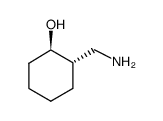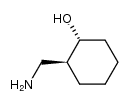trans-2-Aminomethyl-1-cyclohexanol
Modify Date: 2024-01-30 18:31:30

trans-2-Aminomethyl-1-cyclohexanol structure
|
Common Name | trans-2-Aminomethyl-1-cyclohexanol | ||
|---|---|---|---|---|
| CAS Number | 5691-09-8 | Molecular Weight | 129.20000 | |
| Density | N/A | Boiling Point | 226.4ºC at 760mmHg | |
| Molecular Formula | C7H15NO | Melting Point | N/A | |
| MSDS | N/A | Flash Point | 90.7ºC | |
| Name | trans-2-Aminomethyl-1-cyclohexanol |
|---|---|
| Synonym | More Synonyms |
| Boiling Point | 226.4ºC at 760mmHg |
|---|---|
| Molecular Formula | C7H15NO |
| Molecular Weight | 129.20000 |
| Flash Point | 90.7ºC |
| Exact Mass | 129.11500 |
| PSA | 46.25000 |
| LogP | 1.19650 |
| Appearance of Characters | Liquid After Melting | Clear colorless |
| Index of Refraction | 1.4905-1.4925 |
Synonym: Section 2 - COMPOSITION, INFORMATION ON INGREDIENTS
Risk Phrases: None Listed. Section 3 - HAZARDS IDENTIFICATION EMERGENCY OVERVIEW
Moisture sensitive. Potential Health Effects Eye: Non-irritating to the eyes. Skin: Non-irritating to the skin. May be harmful if absorbed through the skin. Ingestion: May be harmful if swallowed. Inhalation: May be harmful if inhaled. Chronic: Not available. Section 4 - FIRST AID MEASURES Eyes: Flush eyes with plenty of water for at least 15 minutes, occasionally lifting the upper and lower eyelids. Get medical aid. Skin: Get medical aid. Flush skin with plenty of soap and water for at least 15 minutes while removing contaminated clothing and shoes. Ingestion: Get medical aid. Wash mouth out with water. Inhalation: Remove from exposure to fresh air immediately. Get medical aid. Notes to Physician: Section 5 - FIRE FIGHTING MEASURES General Information: As in any fire, wear a self-contained breathing apparatus in pressure-demand, MSHA/NIOSH (approved or equivalent), and full protective gear. Extinguishing Media: Use water spray, dry chemical, carbon dioxide, or chemical foam. Section 6 - ACCIDENTAL RELEASE MEASURES General Information: Use proper personal protective equipment as indicated in Section 8. Spills/Leaks: Vacuum or sweep up material and place into a suitable disposal container. Section 7 - HANDLING and STORAGE Handling: Avoid breathing dust, vapor, mist, or gas. Avoid contact with skin and eyes. Storage: Store in a cool, dry place. Store in a tightly closed container. Store under nitrogen. Section 8 - EXPOSURE CONTROLS, PERSONAL PROTECTION Engineering Controls: Use adequate ventilation to keep airborne concentrations low. Personal Protective Equipment Eyes: Not available. Skin: Wear appropriate protective gloves to prevent skin exposure. Clothing: Wear appropriate protective clothing to prevent skin exposure. Respirators: Follow the OSHA respirator regulations found in 29CFR 1910.134 or European Standard EN 149. Always use a NIOSH or European Standard EN 149 approved respirator when necessary. Section 9 - PHYSICAL AND CHEMICAL PROPERTIES Physical State: Slurry Appearance: white Odor: Not available. pH: Not available. Vapor Pressure: Not available. Viscosity: Not available. Boiling Point: 100 - 102 deg C @ 2 Freezing/Melting Point: Not available. Autoignition Temperature: Not available. Flash Point: Not available. Explosion Limits, lower: Not available. Explosion Limits, upper: Not available. Decomposition Temperature: Solubility in water: Specific Gravity/Density: Molecular Formula: C7H15NO Molecular Weight: 129.20 Section 10 - STABILITY AND REACTIVITY Chemical Stability: Stable under normal temperatures and pressures. Conditions to Avoid: Incompatible materials, exposure to moist air or water. Incompatibilities with Other Materials: Strong oxidizing agents. Hazardous Decomposition Products: Carbon monoxide, oxides of nitrogen, carbon dioxide. Hazardous Polymerization: Has not been reported. Section 11 - TOXICOLOGICAL INFORMATION RTECS#: CAS# 5691-09-8 unlisted. LD50/LC50: Not available. Carcinogenicity: trans-2-Aminomethyl-1-cyclohexanol - Not listed by ACGIH, IARC, NIOSH, NTP, or OSHA. See actual entry in RTECS for complete information. Section 12 - ECOLOGICAL INFORMATION Section 13 - DISPOSAL CONSIDERATIONS Dispose of in a manner consistent with federal, state, and local regulations. Section 14 - TRANSPORT INFORMATION IATA No information available. IMO No information available. RID/ADR No information available. Section 15 - REGULATORY INFORMATION European/International Regulations European Labeling in Accordance with EC Directives Hazard Symbols: Not available. Risk Phrases: Safety Phrases: S 24/25 Avoid contact with skin and eyes. WGK (Water Danger/Protection) CAS# 5691-09-8: No information available. United Kingdom Occupational Exposure Limits Canada None of the chemicals in this product are listed on the DSL/NDSL list. CAS# 5691-09-8 is not listed on Canada's Ingredient Disclosure List. Exposure Limits US FEDERAL TSCA CAS# 5691-09-8 is not listed on the TSCA inventory. It is for research and development use only. SECTION 16 - ADDITIONAL INFORMATION N/A |
|
~% 
trans-2-Aminome... CAS#:5691-09-8 |
| Literature: Bulletin de la Societe Chimique de France, , p. 878,885 |
| Precursor 1 | |
|---|---|
| DownStream 0 | |
| HS Code | 2922199090 |
|---|---|
| Summary | 2922199090. other amino-alcohols, other than those containing more than one kind of oxygen function, their ethers and esters; salts thereof. VAT:17.0%. Tax rebate rate:13.0%. . MFN tariff:6.5%. General tariff:30.0% |
| MFCD00145420 |
| trans-2-aminomethyl-1-cyclohexanol |
